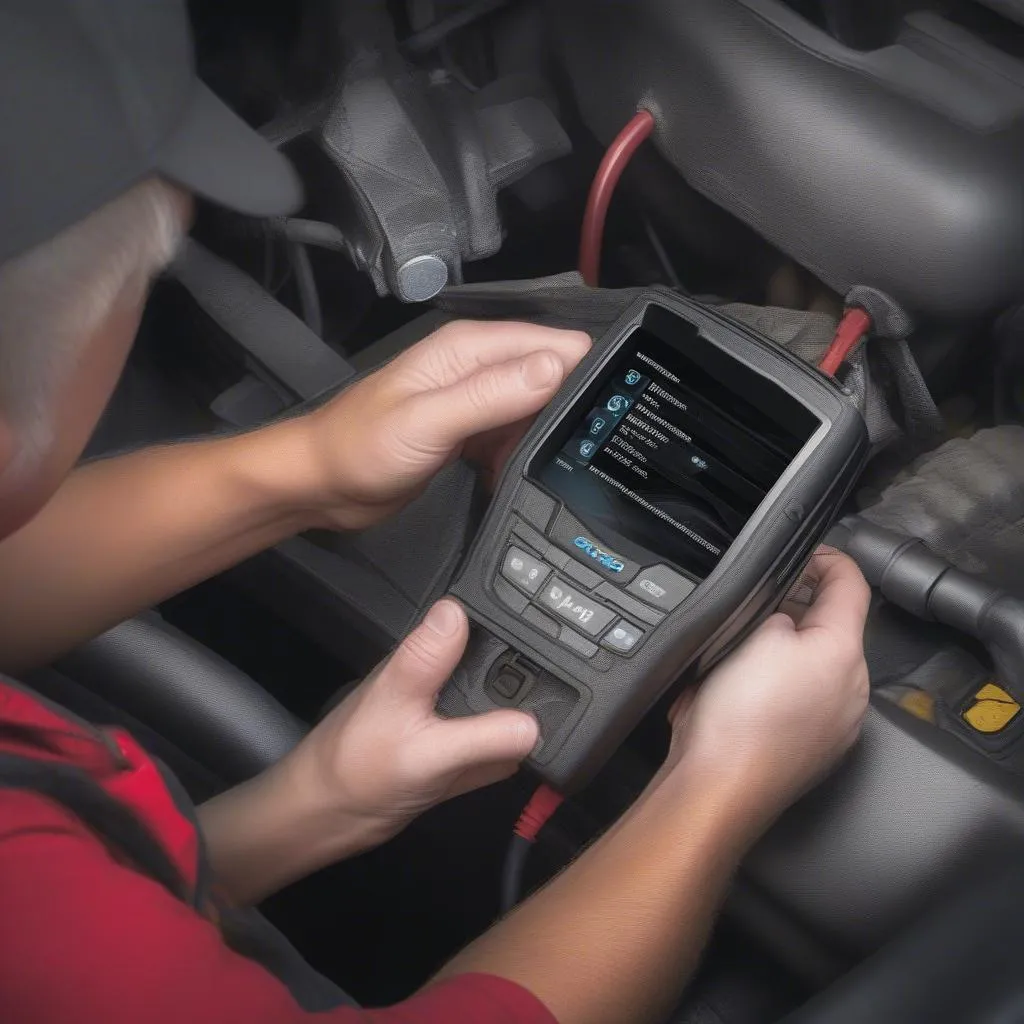Imagine pulling up to a gas station, ready to fill your 2009 Chevrolet Traverse, only to be met with the dreaded “Check Engine” light blinking on your dashboard. You pull over, check the engine oil, and everything seems fine. Then, you remember the OBD code reader you bought for emergencies, and sure enough, it throws up P0420: “Catalyst System Efficiency Below Threshold (Bank 1).” Now what?
What Does the P0420 Code Mean?
P0420 code signals a problem with the catalytic converter, a vital component in your car’s emission control system. Essentially, it means your car’s catalytic converter isn’t functioning at its optimal efficiency.
From a mechanic’s standpoint: The catalytic converter acts like a filter, converting harmful pollutants like carbon monoxide and hydrocarbons into less harmful emissions. When the P0420 code pops up, it signifies that the catalytic converter is failing to effectively neutralize these pollutants, exceeding the acceptable emissions levels.
From a technical perspective: The code is triggered when the oxygen sensor before and after the catalytic converter detect a discrepancy in the amount of oxygen. This indicates the converter isn’t doing its job of transforming pollutants.
From an economic perspective: A faulty catalytic converter not only harms the environment but also hurts your wallet. Failing to fix this issue can lead to increased fuel consumption, reduced engine performance, and potentially even a failed emissions test.
P0420 Code: Understanding and Troubleshooting
Here’s the thing: The P0420 code doesn’t automatically mean you need to replace your catalytic converter. While that is a possible culprit, there are other factors to consider.
Common Causes of the P0420 Code:
- Faulty catalytic converter: This is the most common cause, and it’s often due to age, mileage, or exposure to extreme heat.
- Faulty oxygen sensor: The oxygen sensor before or after the catalytic converter can malfunction, leading to inaccurate readings and triggering the code.
- Fuel system problems: Leaking injectors, misfiring cylinders, or clogged fuel lines can also impact the catalytic converter’s efficiency.
- Engine misfire: A misfire can lead to excess unburned fuel reaching the catalytic converter, causing damage and triggering the code.
- Exhaust leak: Leaks in the exhaust system can cause unburned gases to bypass the catalytic converter, resulting in the code.
Troubleshooting the P0420 Code:
- Inspect the catalytic converter: If your Traverse has accumulated significant mileage, it’s possible the catalytic converter is aging. Inspect it for signs of damage, such as holes, cracks, or blockage.
- Check the oxygen sensors: Use a diagnostic scanner to assess the performance of the oxygen sensors before and after the catalytic converter. If they’re reading outside the normal range, they may need to be replaced.
- Diagnose fuel system problems: Check for fuel leaks, faulty injectors, or other fuel system issues.
- Address engine misfires: If your engine is misfiring, address the underlying issue.
- Examine the exhaust system: Inspect the exhaust system for leaks.
Need to fix the problem quickly?  OBD code reader and diagnostic tool A qualified mechanic with experience in European car systems can help diagnose and repair the issue efficiently.
OBD code reader and diagnostic tool A qualified mechanic with experience in European car systems can help diagnose and repair the issue efficiently.
Additional Tips:
- Use high-quality fuel: Using lower-quality fuel can lead to build-up in the catalytic converter, impacting its efficiency.
- Regular maintenance: Follow the manufacturer’s recommended maintenance schedule, including oil changes and spark plug replacements.
- Avoid prolonged idling: Idling for extended periods can cause excessive heat and strain on the catalytic converter.
Frequently Asked Questions:
Q: How do I reset the P0420 code?
- A: Simply resetting the code won’t fix the underlying issue. It will temporarily clear the check engine light but likely return if the problem persists.
Q: Will my car pass emissions testing with a P0420 code?
- A: No, you’ll likely fail emissions testing. Fixing the issue is essential for ensuring your Traverse passes the test.
Q: How much does a catalytic converter replacement cost?
- A: The cost varies depending on the model of your Traverse and your location. You can expect to pay between $500 and $2000 for a new catalytic converter.
Q: Can I drive my car with the P0420 code?
- A: Yes, you can drive your Traverse, but it’s crucial to address the issue as soon as possible. A malfunctioning catalytic converter can lead to damage to other parts of the exhaust system.
Q: Is there a way to fix the P0420 code without replacing the catalytic converter?
- A: In some cases, cleaning or replacing the oxygen sensors or addressing other underlying issues might resolve the code. However, a damaged catalytic converter often requires replacement.
Related Articles:
- 2009 Chevrolet Traverse OBD Code P0420: Understanding and Troubleshooting
- 2012 Traverse OBD Codes: A Comprehensive Guide
- 09 Traverse OBD P2097 Code: What It Means and How to Fix It
- Chevy OBD Trouble Codes: A Guide for Car Owners
Need Help?
If you’re facing the P0420 code in your 2009 Chevrolet Traverse, don’t hesitate to contact us! Our team of expert mechanics can help you diagnose and repair the issue efficiently.  Professional mechanic diagnosing and repairing P0420 code Contact us via Whatsapp: +84767531508 for 24/7 support.
Professional mechanic diagnosing and repairing P0420 code Contact us via Whatsapp: +84767531508 for 24/7 support.
Remember, early diagnosis and proper repair are crucial for your car’s performance and safety. We hope this guide has helped you understand the P0420 code and how to address it effectively. Share your experiences with us in the comments below, and stay tuned for more insightful content on car care and repair!